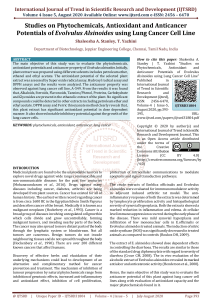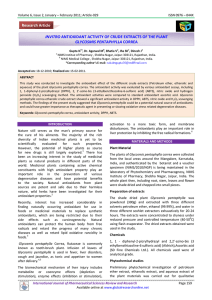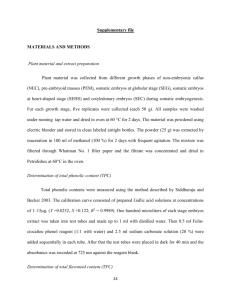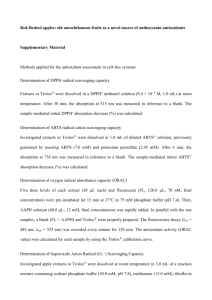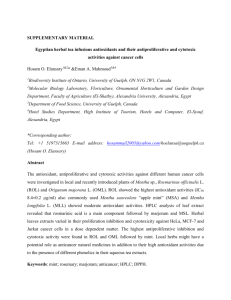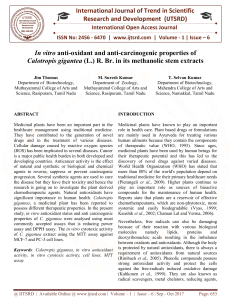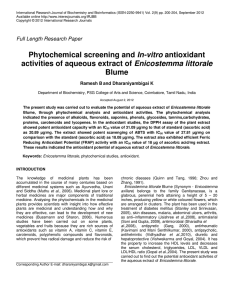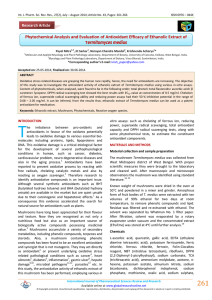Document 13308687
advertisement
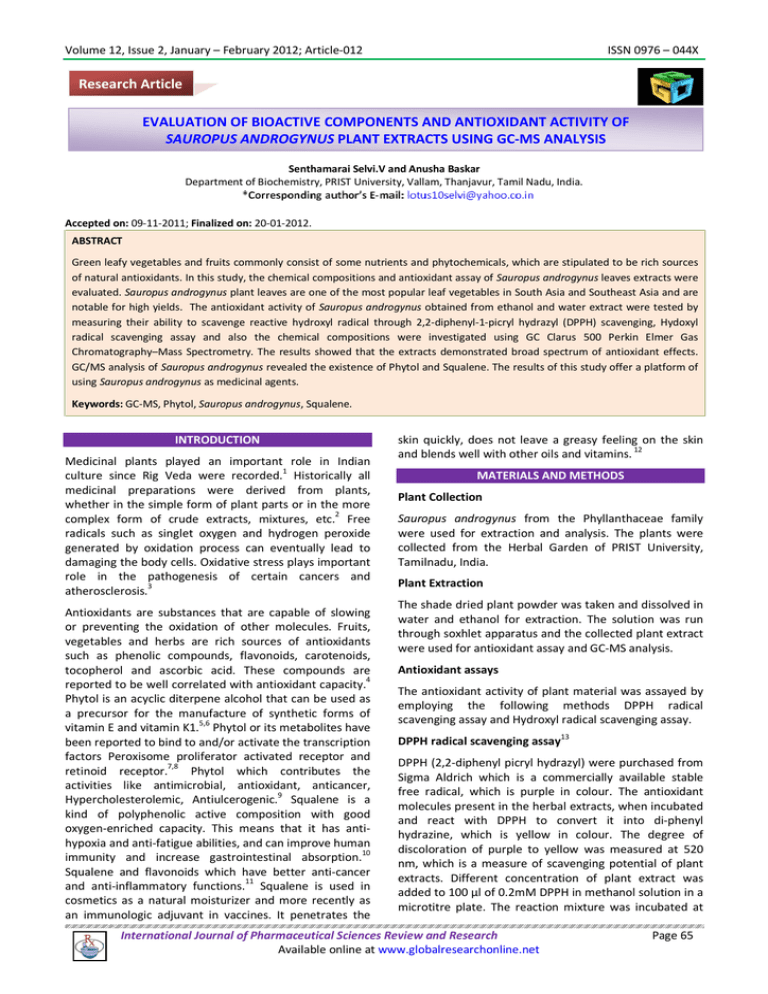
Volume 12, Issue 2, January – February 2012; Article-012 ISSN 0976 – 044X Research Article EVALUATION OF BIOACTIVE COMPONENTS AND ANTIOXIDANT ACTIVITY OF SAUROPUS ANDROGYNUS PLANT EXTRACTS USING GC-MS ANALYSIS Senthamarai Selvi.V and Anusha Baskar Department of Biochemistry, PRIST University, Vallam, Thanjavur, Tamil Nadu, India. Accepted on: 09-11-2011; Finalized on: 20-01-2012. ABSTRACT Green leafy vegetables and fruits commonly consist of some nutrients and phytochemicals, which are stipulated to be rich sources of natural antioxidants. In this study, the chemical compositions and antioxidant assay of Sauropus androgynus leaves extracts were evaluated. Sauropus androgynus plant leaves are one of the most popular leaf vegetables in South Asia and Southeast Asia and are notable for high yields. The antioxidant activity of Sauropus androgynus obtained from ethanol and water extract were tested by measuring their ability to scavenge reactive hydroxyl radical through 2,2-diphenyl-1-picryl hydrazyl (DPPH) scavenging, Hydoxyl radical scavenging assay and also the chemical compositions were investigated using GC Clarus 500 Perkin Elmer Gas Chromatography–Mass Spectrometry. The results showed that the extracts demonstrated broad spectrum of antioxidant effects. GC/MS analysis of Sauropus androgynus revealed the existence of Phytol and Squalene. The results of this study offer a platform of using Sauropus androgynus as medicinal agents. Keywords: GC-MS, Phytol, Sauropus androgynus, Squalene. INTRODUCTION Medicinal plants played an important role in Indian culture since Rig Veda were recorded.1 Historically all medicinal preparations were derived from plants, whether in the simple form of plant parts or in the more complex form of crude extracts, mixtures, etc.2 Free radicals such as singlet oxygen and hydrogen peroxide generated by oxidation process can eventually lead to damaging the body cells. Oxidative stress plays important role in the pathogenesis of certain cancers and atherosclerosis.3 Antioxidants are substances that are capable of slowing or preventing the oxidation of other molecules. Fruits, vegetables and herbs are rich sources of antioxidants such as phenolic compounds, flavonoids, carotenoids, tocopherol and ascorbic acid. These compounds are reported to be well correlated with antioxidant capacity.4 Phytol is an acyclic diterpene alcohol that can be used as a precursor for the manufacture of synthetic forms of vitamin E and vitamin K1.5,6 Phytol or its metabolites have been reported to bind to and/or activate the transcription factors Peroxisome proliferator activated receptor and 7,8 retinoid receptor. Phytol which contributes the activities like antimicrobial, antioxidant, anticancer, 9 Hypercholesterolemic, Antiulcerogenic. Squalene is a kind of polyphenolic active composition with good oxygen-enriched capacity. This means that it has antihypoxia and anti-fatigue abilities, and can improve human immunity and increase gastrointestinal absorption.10 Squalene and flavonoids which have better anti-cancer and anti-inflammatory functions.11 Squalene is used in cosmetics as a natural moisturizer and more recently as an immunologic adjuvant in vaccines. It penetrates the skin quickly, does not leave a greasy feeling on the skin and blends well with other oils and vitamins. 12 MATERIALS AND METHODS Plant Collection Sauropus androgynus from the Phyllanthaceae family were used for extraction and analysis. The plants were collected from the Herbal Garden of PRIST University, Tamilnadu, India. Plant Extraction The shade dried plant powder was taken and dissolved in water and ethanol for extraction. The solution was run through soxhlet apparatus and the collected plant extract were used for antioxidant assay and GC-MS analysis. Antioxidant assays The antioxidant activity of plant material was assayed by employing the following methods DPPH radical scavenging assay and Hydroxyl radical scavenging assay. DPPH radical scavenging assay13 DPPH (2,2-diphenyl picryl hydrazyl) were purchased from Sigma Aldrich which is a commercially available stable free radical, which is purple in colour. The antioxidant molecules present in the herbal extracts, when incubated and react with DPPH to convert it into di-phenyl hydrazine, which is yellow in colour. The degree of discoloration of purple to yellow was measured at 520 nm, which is a measure of scavenging potential of plant extracts. Different concentration of plant extract was added to 100 µl of 0.2mM DPPH in methanol solution in a microtitre plate. The reaction mixture was incubated at International Journal of Pharmaceutical Sciences Review and Research Available online at www.globalresearchonline.net Page 65 Volume 12, Issue 2, January – February 2012; Article-012 ISSN 0976 – 044X 0 25 C for 5 minutes, after that the absorbance was measured at 520 nm. Lower the absorbance of the reaction mixture indicates higher free radical scavenging activity. The DPPH with corresponding solvents without plant extract serves as the control. The methanol with respective plant extracts serves as blank. The DPPH radical scavenging activity of the plant extract was calculated as the percentage inhibition. the extraction flask in a water bath at 70-75ᵒC. The distillation-extraction was realized in 3hours; the ethanolic extract was concentrated, dried over anhydrous CaCl2, filtered and analyzed by GC-MS. Standard chemicals were obtained from Fluka, Merck GC grade solvent. The GC-MS analysis of ethanolic plant extract was performed using GC Clarus 500 Perkin Elmer equipped with Mass spectrometer system recording. Software adopted to handle mass spectra and chromatograms was a ChemStation. % Inhibition of DPPH radical = Control – Test / Control x 100 Hydroxyl radical scavenging activity 14 2-Deoxyribose is oxidized by hydroxyl radicals can be detected by reacting with Thiobarbituric acid (TBA). A reaction mixture composed of 0.1ml of 10mM FeSO4.7H2O; 0.1 ml of 10mM Ethylene Diamine Tetra Acetic Acid (EDTA), 0.2ml of 10mM 2-deoxyribose and 0.02ml of sample in 1.38ml of 0.1mM phosphate buffer pH 7.4 was maintained. The reaction was started by adding 0.2ml of 10 mM hydrogen peroxide and incubating at 37ᵒC for 1hr. After incubation, 1ml each of 2.8% Trichloroacetic acid (TCA) solution and 1ml of 1% Thiobarbituric acid (TBA) solution were added to the reaction mixture, which was then boiled for 10min, cooled in ice and its absorbance recorded at 532 nm. % Inhibition of Hydroxyl radical scavenging = RESULTS The extracts of Sauropus androgynus plant at different concentrations ranging from 20 to 200 µg /ml were tested for their ability to scavenge free radicals generated by in vitro systems study. From the results, it has been noted that the free radical-scavenging activity of the plant extracts increases in a concentration. Accordingly the ethanolic extract of Sauropus androgynus showed around 10-12 compounds using GC/MS analysis and it is read to compare with NIST/NBS spectral database. DISCUSSION The ethanolic extract of Sauropus androgynus leaf were 66.06% and aqueous extract of were 62.02% possessed the inhibition of DPPH radical (Table: 1). Likewise in Hydroxyl radical assay, OH- radicals degrade 2deoxyribose to malodialdehyde. The oxidized products from the reaction from complexes with TBA and show a pink color. The antioxidants of crude extract decreased formation of oxidized product of 2-deoxyribose leading to less formation of thiobarbituric acid reactive substances (TBARS). The ethanolic fraction of Sauropus androgynus possessed slight higher inhibition of 51.08% in ethanolic extract and aqueous extract exhibit similar inhibition of about 50.05%. Control – Test/Control x 100 Gas chromatography–mass spectrometry (GC/MS) and mass spectrometer analysis Sauropus androgynus plant leaves were subjected to the steam-distillation/extraction by weighing 50 g finely grounded shade dried sample and 250 ml distilled water were added to a 500 ml three neck flask (steam distillation flask) and 20 ml ethanol in the extraction flask with boiling regulator. The flasks were connected to the Steam Distillation apparatus with an efficient reflux condenser, the distillation flask was put in an oil bath, and Table 1: Antioxidant Activity of Sauropus androgynus Antioxidant Activity in % Concentration of Extract µg/ml DPPH Activity Hydroxyl radical Activity Aqueous Extract Ethanolic Extract Aqueous Extract Ethanolic Extract 20 10.01 13.03 10.10 12.22 50 30.11 31.05 26.08 27.09 100 62.02 66.06 50.05 51.08 150 99.05 101.01 80.05 84.02 200 120.05 129.09 110.07 127.06 Table 2: GC-MS Analysis of Sauropus androgynus Retention Time Name of the compound Molecular Formula Molecular Weight % Peak Area 15.00 Phytol C20H40O 296 0.88 24.77 Squalene C30H50 410 8.06 International Journal of Pharmaceutical Sciences Review and Research Available online at www.globalresearchonline.net Page 66 Volume 12, Issue 2, January – February 2012; Article-012 The GC/MS analysis showed that at least 10-12 compounds were present in ethanolic extract of Sauropus androgynus. These compounds were identified through mass spectrometry attached with GC. The mass spectra of these compounds were matched with those found in the NIST/NBS spectral database and the data are given in Table 2. The major compound retention time 24.77min was Squalene found to be 8.06% relative percentage amount, which contain improve human immunity and 10 other medicinal properties. Phytol was also detected 0.88% relative amount with 15.00 retention time. Phytol is known to possess an antimicrobial, antioxidant 9 activity. ISSN 0976 – 044X 3. Wang, B, Zhang W, Duan X, Li X. In vitro antioxidative activities of extract and semi-purified fractions of the marine red algae, Rhodomela confervoides (Rhodomelaceae). Food Chem., 113:2009, 1101-1105. 4. Katalinic, V, Milos M, Modun D, Music I, Boban M, Antioxidant effectiveness of selected wines in comparison with (+) catechin. Food Chem., 86:2004, 593-600. 5. Netscher, T, Synthesis of Vitamin E. Vitamins & Hormones. 76, 2007, 155-202. 6. Daines, A.M., The synthesis of naturally occurring Vitamin K and Vitamin K analogues. Current Organic Chemistry 7, 2003, 1625-1634. 7. Gloerich, J., A phytol-enriched diet induces changes in fatty acid metabolism in mice both via PPARalphadependent and -independent pathways. Journal of Lipid Research 46, 2005, 716-726. 8. Kitareewan, S., Phytol metabolites are circulating dietary factors that activate the nuclear receptor RXR. Molecular Biology of the Cell 7, 1996, 1153-1166. 9. Praveen Kumar, P., Kumaravel, S., Lalitha, C, Screening of antioxidant activity, total phenolics and GC-MS study of Vitex negundo African Journal of Biochemistry Research. Volume 4(7), 2011, pp.191-195. 10. Zhao, A.Y. Development of natural antioxidant tea polyphenol. China Food Additives, 5:2005, 78-80. 11. Liao, SJ, Ji DL, Tong HR, Study on fatty acid compostion and nutrition health protection function of the Oil tea Camellia Seed Oil.Food oil, 6:2005, 7-9. 12. Christian, MS, Final report on the safety assessment of squalane and squalene". J. Am. College Toxicol., 1(2):1982, 37-56. 13. Mensor, LL, Meneze FS, Leitao., Screening of Brazilian plant extracts for antioxidant activity by the use of DPPH free radical method. Phytother.Res.15, 2001, 127-130. 14. Chung, S.K., Osawa T., Kawakishi S. Hydroxyl radicalscavenging effects of spices and scavengers from brown mustard (Brassica nigra). Biosci.Biotech.Biochem. 61:1997, 118-123. 15. Aibinu, I., Medicinal plants as antimicrobials. In. T.Odugbemi. Outlines and pictures of medicinal plants from Nigeria. University of Lagos press, Nigeria, 2006, 5364. CONCLUSION Efforts in this regard have focussed on plants because of their use historically and the fact that a good portion of the world’s population rely on plants for the treatment of 15 infections and non infectious diseases. The ethanolic extracts of Sauropus androgynus leaves have demonstrated a broad spectrum of anti-tussive, tonic and relieve internal fever.16 The present investigation may be used to authenticate the scientific reason of free radical-scavenging with use of plant in the treatment or prevention of the onset of deadly disorders like arthritis, breast cancer, atherosclerosis, etc. And also it is a right step in the direction of searching for novel and more effective Gas chromatography and mass spectroscopy analysis which showed the existence of various compounds with variable chemical structures. At end point it is conclude that the in vivo studies on biological systems can open up new way for natural antioxidants that can also be employed for clinical trials which may generate successful results in future. Acknowledgement: This work was supported by the Center for Research and Development, PRIST University, Vallam, Thanjavur, Tamil Nadu, India. REFERENCES 1. 2. Miura T, Itoh Y, Iwamoto N, Kato M, Ishida T, Suppressive activity of the fruit of Momordica charantia with exercise on blood glucose in type 2 diabetes mice. Biol. Pharmaceut. Bulletin, 27:2004, 248-250 Ayyanar, M., Ignacimuthu, S Herbal medicines for wound healing among tribal people in Southern India: Ethnobotanical and Scientific evidences. Int. J. Appl. Res. Nat. Prod., 2(3):2009, 29-42. 16. Rob Fletcher, School of Land and Food. The University of Queensland Gatton College. Australian Newcrops Newsletter, Australia (Access from www.google.com. On 15/10/2009). ********************** International Journal of Pharmaceutical Sciences Review and Research Available online at www.globalresearchonline.net Page 67


